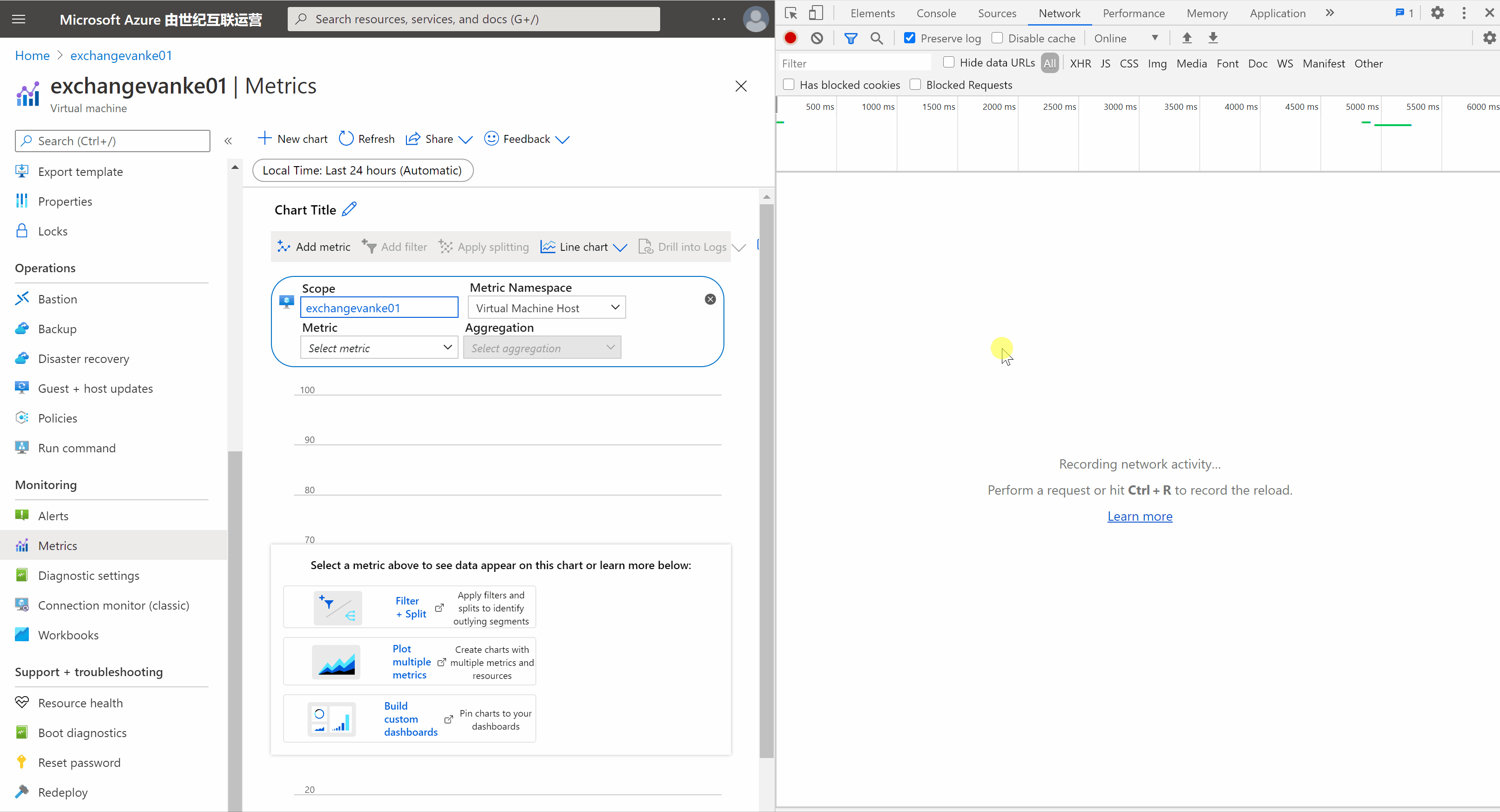问题描述
在Azure上创建虚拟机(VM)后,在门户上可以查看监控指标(Metrics),如CPU Usage,Memory,Disk I/O等。那如何通过Java 代码获取到这些指标呢?
关于VM 的内存使用率,虚拟机本身并没有提供这个指标,需要开启诊断后去Azure Storage表中获取,字段为Memory\% Committed Bytes In Use,是开启了诊断日志存储到WADMetrics 表中
解决办法
方式一:使用REST API
Azure中门户上看见的内容都是通过REST API来获取值,基于此原理,可以通过在门户中Metrics页面中,点看CPU的指标数据后,通过F12(开发者工具),查看具体使用的是什么API, 并参考同样的方式在Java 代码中调用该类接口来完成。

通常情况,是可以在Azure Monitor官网中(https://docs.microsoft.com/zh-cn/rest/api/monitor/)找到需要的REST API接口。如:
Metrics - List
列出资源的指标值。
GET https://management.azure.com/{resourceUri}/providers/microsoft.insights/metrics?api-version=2018-01-01GET https://management.azure.com/{resourceUri}/providers/microsoft.insights/metrics?timespan={timespan}&interval={interval}&metricnames={metricnames}&aggregation={aggregation}&top={top}&orderby={orderby}&$filter={$filter}&resultType={resultType}&api-version=2018-01-01&metricnamespace={metricnamespace}
上文截图中调用通过API获取到的Metrics的URL参数值为:"/subscriptions/<subscriptionid>/resourceGroups/<resource group>/providers/Microsoft.Compute/virtualMachines/<vm name>/providers/microsoft.Insights/metrics?
timespan=2020-11-24T22:03:01.141Z/2020-11-27T04:55:40.325Z
&interval=PT30M
&metricnames=Percentage CPU
&aggregation=average
&metricNamespace=microsoft.compute%2Fvirtualmachines
&autoadjusttimegrain=true
&validatedimensions=false
&api-version=2019-07-01"参数的详细说明:
Name In Required Type Description path True
- string
资源的标识符。
query True
- string
客户端 Api 版本。
query
- string
$filter用于减少返回的指标数据集。
query
- string
要检索的聚合类型(逗号分隔)的列表。
query duration
- string
查询的间隔(即时粒)。
query
- string
要检索的指标(逗号分隔)的名称。
query
- string
用于查询指标定义的指标命名空间。
query
- string
用于对结果进行排序的聚合和排序方向。 只能指定一个订单。 示例:总和 asc。
query 减少收集的数据集。 允许的语法取决于操作。 有关详细信息,请参阅操作说明。
query
- string
查询的时间跨度。 它是具有以下格式"startDateTime_ISO/endDateTime_ISO"的字符串。
query int32
- integer
要检索的最大记录数。 仅在指定$filter时有效。 默认值为 10。
全文内容:https://docs.microsoft.com/zh-cn/rest/api/monitor/metrics/list
方式二:使用Azure VM诊断日志 ——> Storage Table——> Java Code (Storage SDK)
开启虚拟机的诊断日志,让Azure VM把监控数据发送到Storage Table中,通过Storage SDK直接获取Table中的数据。
开启诊断日志

获取Storage Table中数据的Java代码
若要对表查询分区中的实体,可以使用
TableQuery。 调用TableQuery.from可创建针对特定表的查询,该查询将返回指定的结果类型。 以下代码指定了一个筛选器,用于筛选其中的分区键是“Smith”的实体。TableQuery.generateFilterCondition是用于创建查询筛选器的帮助程序方法。 对TableQuery.from方法返回的引用调用where,以对查询应用筛选器。 当通过调用CloudTable对象上的execute来执行查询时,该查询将返回指定了CustomerEntity结果类型的Iterator。 然后,可以利用在“ForEach”循环中返回的Iterator来使用结果。 此代码会将查询结果中每个实体的字段打印到控制台。try { // Define constants for filters. final String PARTITION_KEY = "PartitionKey"; final String ROW_KEY = "RowKey"; final String TIMESTAMP = "Timestamp"; // Retrieve storage account from connection-string. CloudStorageAccount storageAccount = CloudStorageAccount.parse(storageConnectionString); // Create the table client. CloudTableClient tableClient = storageAccount.createCloudTableClient(); // Create a cloud table object for the table. CloudTable cloudTable = tableClient.getTableReference("people"); // Create a filter condition where the partition key is "Smith". String partitionFilter = TableQuery.generateFilterCondition( PARTITION_KEY, QueryComparisons.EQUAL, "Smith"); // Specify a partition query, using "Smith" as the partition key filter. TableQuery<CustomerEntity> partitionQuery = TableQuery.from(CustomerEntity.class) .where(partitionFilter); // Loop through the results, displaying information about the entity. for (CustomerEntity entity : cloudTable.execute(partitionQuery)) { System.out.println(entity.getPartitionKey() + " " + entity.getRowKey() + " " + entity.getEmail() + " " + entity.getPhoneNumber()); } } catch (Exception e) { // Output the stack trace. e.printStackTrace(); }
参考资料
REST API 引用 Azure Monitor: https://docs.microsoft.com/zh-cn/rest/api/monitor/
如何通过 Java 使用 Azure 表存储或 Azure Cosmos DB 表 API: https://docs.azure.cn/zh-cn/cosmos-db/table-storage-how-to-use-java?toc=https%3A%2F%2Fdocs.azure.cn%2Fzh-cn%2Fstorage%2Ftables%2Ftoc.json&bc=https%3A%2F%2Fdocs.azure.cn%2Fzh-cn%2Fbread%2Ftoc.json
附录一:查看Azure REST API的方法:

附录二:使用Java SDK直接获取VM对象和VM对象中Mertics的代码:https://github.com/Azure/azure-libraries-for-java/blob/master/azure-mgmt-monitor/src/test/java/com/microsoft/azure/management/monitor/MonitorActivityAndMetricsTests.java
/** * Copyright (c) Microsoft Corporation. All rights reserved. * Licensed under the MIT License. See License.txt in the project root for * license information. */ package com.microsoft.azure.management.monitor; import com.microsoft.azure.PagedList; import com.microsoft.azure.management.compute.VirtualMachine; import com.microsoft.azure.management.resources.fluentcore.utils.SdkContext; import org.joda.time.DateTime; import org.junit.Assert; import org.junit.Test; import java.util.List; public class MonitorActivityAndMetricsTests extends MonitorManagementTest { @Test public void canListEventsAndMetrics() throws Exception { DateTime recordDateTime = SdkContext.dateTimeNow().minusDays(40); VirtualMachine vm = computeManager.virtualMachines().list().get(0); // Metric Definition List<MetricDefinition> mt = monitorManager.metricDefinitions().listByResource(vm.id()); Assert.assertNotNull(mt); MetricDefinition mDef = mt.get(0); Assert.assertNotNull(mDef.metricAvailabilities()); Assert.assertNotNull(mDef.namespace()); Assert.assertNotNull(mDef.supportedAggregationTypes()); // Metric MetricCollection metrics = mDef.defineQuery() .startingFrom(recordDateTime.minusDays(30)) .endsBefore(recordDateTime) .withResultType(ResultType.DATA) .execute(); Assert.assertNotNull(metrics); Assert.assertNotNull(metrics.namespace()); Assert.assertNotNull(metrics.resourceRegion()); Assert.assertEquals("Microsoft.Compute/virtualMachines", metrics.namespace());